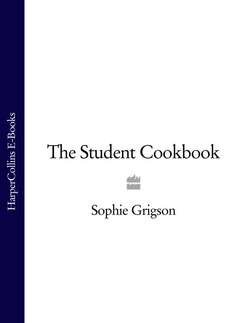Читать книгу The Student Cookbook - Sophie Grigson, Sophie Grigson - Страница 21
Recommended Kitchen Utensils
ОглавлениеIt is impossible to make one definitive list of the essential cooking implements and utensils you will need. Absolute basics are fairly obvious – with nothing but one sharp knife and a frying pan or saucepan, you could turn out a fair number of severely streamlined meals. After that, the list is dictated as much by what you like to cook as anything else.
View your ‘batterie de cuisine’ (cooking equipment) as a long-term collection that you will build up over the years. Sadly, the general rule is that the more you spend, the better the quality, and better quality often makes for easier, more enjoyable cooking. So, no long list but instead a few notes and recommendations on useful kitchen kit, and recommended buys.
Casserole Every home should have one (unless, of course, you loathe stews of any sort). Best bet is a flame- and heatproof casserole that can go both on the hob and in the oven. It should also look good enough to go straight from the oven to the table. It is better to buy a larger casserole dish than a smaller one, allowing plenty of room. After all, most stews improve in flavour if kept for a day or two in the fridge, or can be frozen if necessary, so making a big potful is a pretty sensible thing to do, even if you are just cooking for one or two.
Chopping Boards Hard to do without, so again, buy the best and biggest you can afford. It is far more useful to have one really big wooden chopping board, than several small book-sized ones. Chopping boards should be made of wood (which scientists now consider perfectly hygienic as long as you wash them after use) or plastic.
Food Processor You can manage very well without one, but your kitchen life will become a good deal easier with. Here, as so often, you should probably head for the best you can afford. Choose one with a relatively large capacity, and several different speed settings. Several models have small inner bowls that can be fitted to process small amounts – very useful for making curry pastes and spice rubs, amongst other things.
Frying Pan, Non-stick Another investment item. A really tip-top heavy-based non-stick frying pan does not come cheap, but is worth every penny. Choose one that is fairly large with high sides so that as well as frying, you can also cook a chicken stew and the like in it. Incidentally, modern nonstick surfaces are very tough, so it is usually all right to use metal implements in them.
Graters Don’t get too fancy. An old-fashioned box grater does the job very nicely. I like the modern Microplane graters, too, especially for orange and lemon zest, or Parmesan, or nutmeg.
Kitchen Tongs These do make turning practically anything in a frying pan or under the grill ten times easier and quicker.
Knives Buy the best you can afford (or ask some nice relative with more money than you to make a gift of them). A good knife will last you a lifetime. They’re not cheap, but since you will be using them constantly, knives should be seen as a major investment. You will need, at the very least, one fairly big chef’s knife (around 17.5-20cm /7-8in), one smaller 15cm (6in) knife and a bread knife. A smaller serrated knife (around 10cm/4in) is great for cutting tomatoes.
Knife Sharpener As essential as the knives. A small hand-held knife sharpener is easier.
Liquidiser If I had to choose, I’d say that a liquidiser is more essential than a processor and a darn sight cheaper, too. Liquidisers are important for making soup and smoothies amongst other things. For more on liquidisers, turn to page 17.
Pestle and Mortar Two most important characteristics: firstly, that the mortar needs to be heavy, so that it doesn’t slip and slide around on the table. Secondly, the interior must feel rough. If it is smooth it will make grinding and pounding hard work. Best pestles are rough at the wider end, rather than smooth.
Saucepans You’ll need one small one, one medium-sized one and one large. And no doubt you will add more over the years. When choosing your saucepans, look for solid, heavy bases that will conduct heat evenly.
Sieve I prefer metal, but modern nylon sieves are fine. More important than the material is the mesh size. This should be fairly large. If the mesh is too fine, then it can makes things like sieving a soup a complete nightmare. Never buy a sieve which doesn’t have one or two hooks on the rim opposite the handle, so that you can sit the sieve securely over a bowl or saucepan.
Weighing Scales Digital scales are far more accurate than most dial scales. Buy scales with a flattop, so that you can use any bowl or pan on them, resetting the display to zero before weighing out ingredients.
